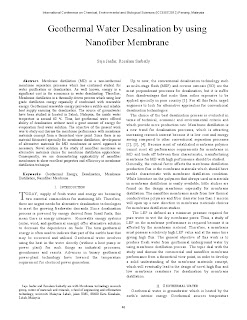Potable water is currently among one of the commodity which we essentially need. There are many placed industrially polluted water sources or places where is lack of fresh drinking water. Therefore is it necessary to deal with alternative technologies to obtain drinking water. One of them is desalination. Seawater desalination is energy intensive (and thus expensive) process. Nowadays, there is a space for renewable energy sources, which gives us energy from the sun, wind and earth (solar, wind and geothermal energy).

So why not try it out to get potable water from geothermal water? Scientists from the University Malaysia Sabah are engaged in this idea currently. They decided to get potable water from geothermal water desalination using nanofibrous membranes. Their results have been presented at the International Conference on Chemical, Biological and Environmental Sciences (ICCEBS'2012) in Penang, Malaysia recently.
Geothermal water is obtained from deep wells in most cases, and its energy is used for electricity production or heating. The major disadvantage is the strong mineralization (by sodium, calcium, copper, iron, sulfates, chlorides, etc.), which causes technological elements fouling. This water must be desalinated to be potable according to the applicable standards recommended by WHO.
Source of groundwater is located in Sabah, Malaysia. This geothermal water has a temperature around 60 °C, which should be enough for desalination without the large energy invested amount. At the same time, they tried to develop an alternative material for the membrane distillation - nanofibrous membrane.
At present, the conventional technologies (reverse osmosis and multistage flash distillation) are used in seawater desalination. The main disadvantage of these technologies is the final price. Membrane distillation is economically feasible and environmentally acceptable alternative and is becoming a new trend in the field of desalination. The principle of membrane distillation is based on the different volatility of each individual substance and driving force of this process is the vapor pressure difference.
 |
Water movement through the membrane is due to vapor pressure imbalances (according to corresponding temperature differences) between the membrane parts. The water evaporation occurs at the input (retention) side of the membrane, in which some components are dissolved in the membrane, diffuse through the membrane and evaporate at the permeate side. Water vapor moves through the membrane until it reaches the low water vapor concentration at the pore outlet (permeate part), where condense and can be collected as pure water.
The greatest demands are to the membrane and its characteristics (hydrophobicity, durability, low thermal conductivity, high efficiency and high mass flux). The membrane must be thin, because the permeate flux is indirectly proportional to the membrane thickness. Hydrophobic nature prevents the liquid water penetration through the membrane pores, but allows water vapor passage.
Nanofibrous membrane of polyvinylidene fluoride (PVDF) has been tested. Water flux was higher in comparison with conventional PVDF membrane (11.16 kg/m2.hr at differences in temperatures from 22 to 82 ° C). Nanofibers offer attractive characteristics - highsurface area, porosity, open interconnected pore structure and a low membrane thickness. A few disadvantages also exist - low membrane resistance and low LEP (the minimum pressure required to pure water to wet dry membrane pores), which leads to fluids penetration into and through the membrane pores. However, the filtration efficiency reached 90.7 to 99.9% and the porosity of the nanofibrous membrane was higher than 70%.
Nanofibrous membrane of polyvinylidene fluoride (PVDF) has been tested. Water flux was higher in comparison with conventional PVDF membrane (11.16 kg/m2.hr at differences in temperatures from 22 to 82 ° C). Nanofibers offer attractive characteristics - highsurface area, porosity, open interconnected pore structure and a low membrane thickness. A few disadvantages also exist - low membrane resistance and low LEP (the minimum pressure required to pure water to wet dry membrane pores), which leads to fluids penetration into and through the membrane pores. However, the filtration efficiency reached 90.7 to 99.9% and the porosity of the nanofibrous membrane was higher than 70%.
Nanofibrous membranes offer great potential for geothermal water desalination, but it is necessary to optimize the technology to adapt nanofibers properties. The result will be an excellent material with high efficiency and high flux, available for developing countries. And there is one the most important thing - more attainable drinking water.
Fonte: Nafigate
